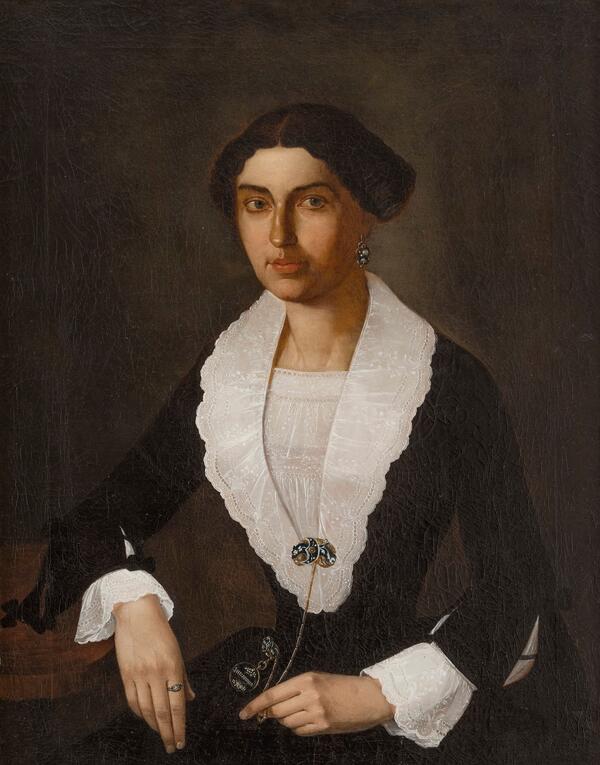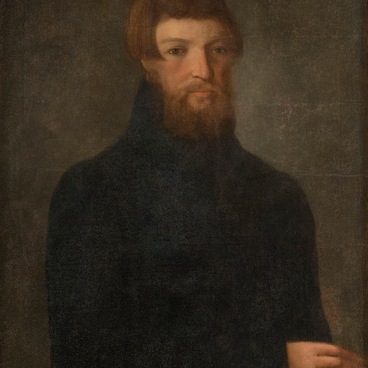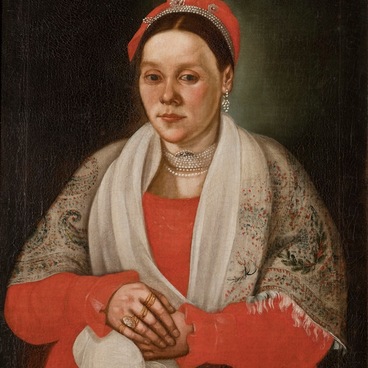The portrait by an unknown artist shows a dark-haired woman with a calm gaze. She poses without a headdress. Her wavy dark brown hair, divided by a straight parting, slightly covers her ears.
The portrayed woman is dressed in a black and white ceremonial outfit. The black dress is waist-fitted, that is it tapers at the waist and opens up a deep neckline with a large collar of fine white embroidery in the front. Under the dress you can see the same type of blouse with puffy cuffs.
The artist depicted in detail the jewelry that makes up a uniform jewelry set: earrings, a brooch, a ring, and a pocket watch with a chain. The ring on the index finger of the right hand most likely indicates the engagement of the heroine of the portrait. She rests her elbow on the edge of a table with a mahogany tabletop.
Researchers assume that this painting depicts Anna Kiseleva, the second wife of merchant Ivan Kiselev, whose portrait is also housed in the museum’s collection. In the hall, these paintings are displayed side by side: the female image is to the left of the male one. Such a mutual arrangement of the spouses has always been characteristic of paired merchant portraits.
An unknown artist created the Kiselevs family portrait around the second half of the 1840s, during the heyday of merchant portraiture. Around the middle of the 1840s, this genre was characterized by “mannerism”, that is showing the portrayed in spectacular poses and costumes. Anna and Ivan Kiselevs were portrayed by the artist in a similar manner: the couple is seated with their elbows leaning somewhat mannered on the tabletop. They deliberately pose for the artist, showing off their quite European hairstyles and rich jewelry.
Anna Kiseleva is portrayed according to the rules of a “mannered” merchant portrait: the artist based the image on contrasting colors, placed the emphasis on the face and large eyes of the heroine, used smooth lines and slightly elongated proportions. The contrasting and ceremonial black-and-white combination of the dress and blouse and the merchant’s well-judged pose bring to mind the early photography technique of daguerreotype which emerged in the 1840s — 1850s. Daguerreotype, and later photography, eventually completely replaced pictorial portraits in merchants’ galleries.
The portrayed woman is dressed in a black and white ceremonial outfit. The black dress is waist-fitted, that is it tapers at the waist and opens up a deep neckline with a large collar of fine white embroidery in the front. Under the dress you can see the same type of blouse with puffy cuffs.
The artist depicted in detail the jewelry that makes up a uniform jewelry set: earrings, a brooch, a ring, and a pocket watch with a chain. The ring on the index finger of the right hand most likely indicates the engagement of the heroine of the portrait. She rests her elbow on the edge of a table with a mahogany tabletop.
Researchers assume that this painting depicts Anna Kiseleva, the second wife of merchant Ivan Kiselev, whose portrait is also housed in the museum’s collection. In the hall, these paintings are displayed side by side: the female image is to the left of the male one. Such a mutual arrangement of the spouses has always been characteristic of paired merchant portraits.
An unknown artist created the Kiselevs family portrait around the second half of the 1840s, during the heyday of merchant portraiture. Around the middle of the 1840s, this genre was characterized by “mannerism”, that is showing the portrayed in spectacular poses and costumes. Anna and Ivan Kiselevs were portrayed by the artist in a similar manner: the couple is seated with their elbows leaning somewhat mannered on the tabletop. They deliberately pose for the artist, showing off their quite European hairstyles and rich jewelry.
Anna Kiseleva is portrayed according to the rules of a “mannered” merchant portrait: the artist based the image on contrasting colors, placed the emphasis on the face and large eyes of the heroine, used smooth lines and slightly elongated proportions. The contrasting and ceremonial black-and-white combination of the dress and blouse and the merchant’s well-judged pose bring to mind the early photography technique of daguerreotype which emerged in the 1840s — 1850s. Daguerreotype, and later photography, eventually completely replaced pictorial portraits in merchants’ galleries.



